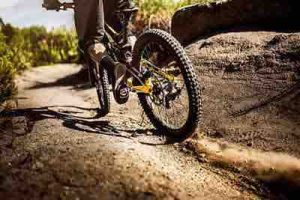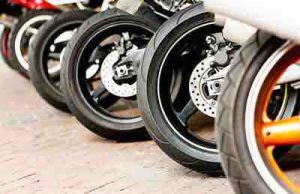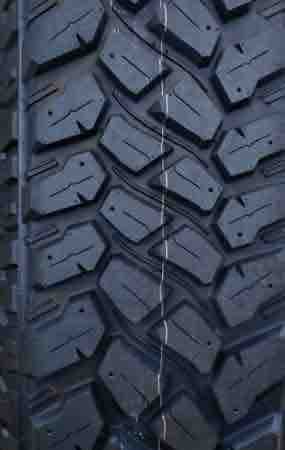Tires are perhaps one of the single most important inventions of human civilization that’s made the rest of our existence easy. It is easy to take for granted the beauty of being able to travel from one point to the other.
This is so because tires mostly work soundlessly underneath our vehicles. Especially when they are screwed on properly. But how tight would a tire be screwed on that would be considered appropriate for safety?
The simple answer is that the tightness of your bike tires should be firm. Your tires should be firm enough for them to move easily and come to a stop also as easily as they naturally should.
They should rotate easily, stop easily, and be easy on both the brakes and your action of propelling it. If what I’ve described doesn’t happen easily then you know your tires are screwed on too tight.
Moreover, each tire has a PSI recommended on the sidewall. Make sure to hit the PSI when you pump so your tire can be as hard as it should be.
To put things in perspective, imagine that you have are at the gas station to get up on gas but you can’t get your gas tank to open because it’s screwed on too tightly. It’s only good for when it’s closed, but how about now you need to refill?
So it is with your tires. When your bike is parked, well, your bike is only great for that, parking. Not for riding.
Table of Contents
How tight should my bike tires feel?

Perhaps after pumping your tire and you are one of those users who stop to dig in your thumb to see how hard it feels.
This act is common with folks who use pumps or gauges they consider inaccurate, hence because they don’t trust their tools, they have to check manually by pressing their thumb in.
I’ve had folks in the tire shop do this, then look up at me and tell me they think they’d have to stop pumping because they’ve not hit the PSI, yet the tire is already hard as a rock.
You have to understand that your thumb can never be an accurate measurement of your tire’s PSI. So how hard should your tire feel?
Your tire should feel as hard as dictated by the recommended PSI. If your tire is a mountain bike, the PSI is likely rated between 20 to 50 PSI. Other tires like gravel and road bike tires are rated at 40 and 90 PSI respectively.
Should bike tires be rock hard?
No, definitely not. Your tires do not have to be pumped all the way to the limit of the recommended PSI.
And it doesn’t have to feel like a rock after pumping it. Do not attempt to pump your tires to rock hard, but if it ever feels like it is that way, then it may be that you have exceeded the pressure limit for your tire and it is overinflated.
Some riders think the harder their tires, the better for riding. This is not true. A rock-hard tire is dangerous to ride on rough terrain.
Most of our roads are not so smooth, a rock-hard tire is quick to bounce off the littlest bumps which may lead to accidents.
Another factor to consider is what kind of rider you are. If you are a big guy, you’d probably have to get your pressure up to the recommended pressure on the sidewall. Lighter riders find that maximum pressure does not really have much negative effect on their riding.
Once again, rock hard is not the best for good riding.
How tight should the bike axle be?
Balance is the key here. I once had to do something about my friend’s bike axle too. I was helping to clean up his garage, I toppled the bike and the axle locking nut on the wheel fell off.
I ended tightening too hard without letting him know about it. One thing’s for sure if the axle is too tight, it becomes difficult to ride, the wheel refuses to spin. And if it’s too loose the hub will be eating up.
So specifically, how tight? I say, just tight enough. Because there is no numerical way to quantify how tight your axle must be, you just have to do it by hand, then test run your bike by rolling it.
One important factor that will help you get the proper tightness is using the proper tools to screw your axle on. There are usually two nuts.
You’d need two cone wrenches to do the tightening by holding the inner nut with one wrench and the outer one with the other wrench.
Be careful to live a gap the size of a hairsbreadth between the two nuts. Then roll the tire, listen, the sound it makes should give you an idea of how it will ride.
Should bike tires be hard?
Yes, they should be hard. The bike is bearing your whole weight on it, the tires in turn carries the weight of the bike with you on it. Hard tires are tires with proper pressure.
If your tires lack proper pressure, you risk having pinch flats, damages to your spokes, rim, and tubes.
A tire that is not hard enough bottoms out every time it hits obstacles like bumps, the sides of curbs, the sides of potholes. Once again, your rim is subjected to damages.
A word of caution though – hard is relative. As I have shown earlier in this article, rock hard is the kind of hard you absolutely want to avoid. Rock hard is too hard, and that is the extreme you do not want to find yourself at.
Tires are designed to take the blows of commuting so do not be afraid to pump and give it appropriate pressure. Hard tires enjoy better traction on the road, they make better rides too.
A tire that is too hard does not have a complete surface grip with the road. Perhaps a better word to describe the right amount of air in your tire is, firm, instead of hard.
Can you squeeze your bike tires?

This is a question I often get from newbies to bike riding as a hobby. A lot of folks are confused about how hard their bike tires should be.
We are caught up between being able to grip and press our fingers into the tires and well, not being able to. As I have said before, a rock-hard tire is not the best. You only want to pump your tire until it is firm.
So should you be able to squeeze your tire? I say yes, you should, to some degree. And the reason is that you do not have to pump your tire to the maximum PSI as recommended by the manufacturer of the tire because your particular road conditions are peculiar to your bike.
If you ride a mountain bike, you might want to leave the PSI at a midrange so that your tire can have more grip as you ascend or descend mountainsides. If this is the case you are sure to be able to squeeze the tire to a certain degree.
Usually, the minimum pressure is set such that it can accommodate the special conditions you ride in, and the maximum may turn out or be too hard for your to ride.
Some bike users prefer to squeeze their tires to gauge the pressure. And it is just as well especially if you are a veteran bike rider and if you are trying to get familiar with a new tire product.
Besides, not being able to squeeze the tire is an indication that the tire is rock hard and the pressure is too much.
How tight should thru-axle be?
The best word to describe how tight your thru-axle should be is snug. Not too tight so that it hurts the frame of your bike, and not too loose so that the tire wobbles when you ride it.
A loose thru-axle is a loose bike frame or dropout. You don’t want your axle too stiff the next time you need to unscrew it.
I can advise that the required torque for your rear wheel nuts should be 300 lbs per inch /34 nM.
For your front wheel, a 180 lbs per inch / 20 nM would be appropriate..
Every bike has a different axle size. The good thing is the manufacturer helps by issuing instructions when you buy the bike anew.
If you have an old bike, maybe one that was handed down to you and you aren’t sure about the axle, you should take it to a repair shop where you’d be shown how to deal with it.
Screw your axle according to your manufacturer’s specified torque value range, that way you are not applying another bike’s torque to yours which may result in the under-torqued axle or an over-torqued axle.
Both extremes are dangerous for your bike.
Related topics:
- Can You Use a Car Tire Pump for a Bike Tire
- Is a Bike Tune-up Worth It
- Can You Use a Car Tire Pressure Gauge on a Bike
- Can a Bike Tire Go Flat Without Holes
- How Long Do Bike Inner Tubes Last

